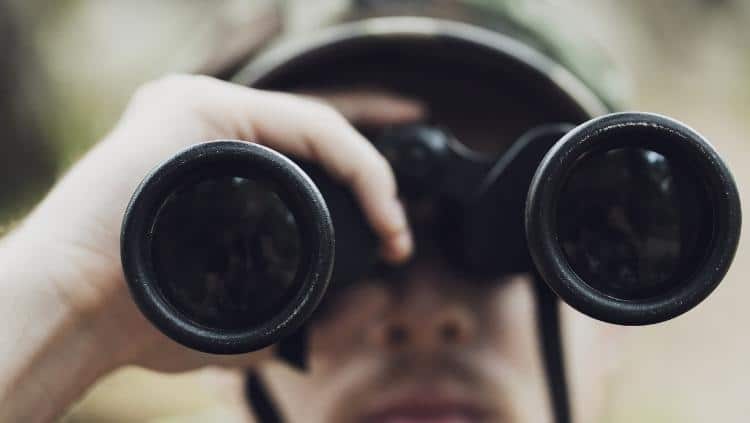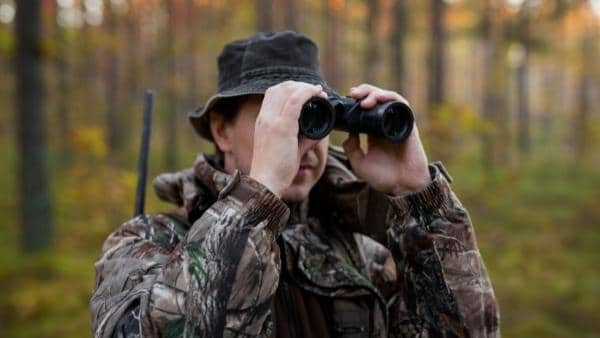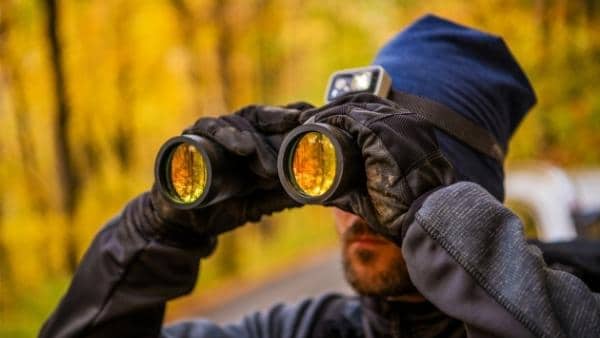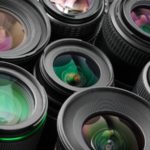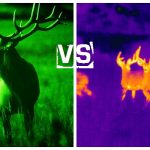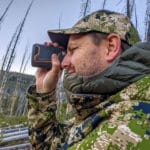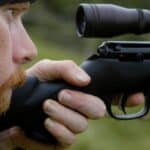The best binocular magnification for you will be determined by more than one interacting element. Before you make a purchase, you should consider them all.
While the best magnification for binoculars is somewhat subjective and you’ll likely get different answers from different people, you’ll probably notice a pattern real quick. That is:
- People will ask you what you want to do with them.
- Most will probably suggest either 8x or 10x magnification as a “do-it-all” option.
The best magnification for binoculars for the widest range of uses is 8x. When paired with a suitable objective lens (e.g. 42mm), 8x magnification maintains a stable image and a sufficiently wide field of view. This helps to spot most game, birds, or wildlife within a few hundred yards.
Now let’s look at some different applications. You’ll want to see our optics recommendations based on what you’re going to use them for.
Finding the Best Magnification for Binoculars
The lens descriptor for binoculars is characterized by two numbers.
The first number represents the binocular’s level of magnification. 8 x 42 binoculars have 8x magnification, which simply means that the object in your view appears 8x closer through the binoculars than it does with the naked eye.
The second number, which is 42 in this example, refers to the objective diameter of the front lens and is measured in millimeters.
Therefore, 8 x 42 binoculars have 8x magnification and a 42mm objective diameter (size of the big lens). The higher the second number, the brighter and sharper the image, usually. This comes at a cost though, weight.
Most 10x binoculars have objectives of 50mm or larger. More glass means more weight. So consider that when shopping around, especially if you’re an ultralight hiker or hunter.
Best Binocular Magnification for Hunting
Birder and hunter binoculars are often grouped into the same category. The reason is that either type typically works for either activity, but it is certainly an advantage to have the right pair based on what you want to do with them.
A good quality pair of hunting binoculars should meet a few standards:
- Not fog easily
- Provide a clear image from any distance, whether it is 50 feet or 500 feet
- Be glare-free, even at night when the sun is low
- Not agitate your eyes after a day’s use
- Provide enough depth of focus to avoid the need to mess with the focus knob as the animal moves closer
The amount of magnification you need for hunting primarily depends on how and where you plan to use the binoculars.
Consider the terrain. Is it super steep and dissected so you can’t even see that far out? Higher magnification will be a waste in this case and 8x will do the trick.
Will you be shooting long range? For example, you’ll need to glass from far away on a western pronghorn antelope hunt. Those animals have incredible eyesight so you need to spot them early and sneak up on them from afar. 10x magnification would be best in this case. And some hunters might use even higher power optics.
If you do not intend to stabilize your binos with a tripod, 8x or 10x magnification is recommended. If you go above that, your image might appear unsteady.
While there is no universal best magnification for hunting binoculars, 8x and 10x are certainly the most popular. The choice depends on your personal preference.
However, you can usually apply the rule that 8x works better for hunting in choppy terrain with a lot of trees and some open space. Whereas 10x provides the extra power you might need for more open terrain, like what you find more frequently in the western US.
Recommended reading: Best Binoculars For Hunting Deer, Elk & Other Game
Best Binocular Magnification for Birding
Birding is a common hobby among Americans, and any serious birder owns a good pair of binoculars. When it comes to finding the best binocular magnification for birding, some might assume that the more power, the better. However, high power has a few drawbacks, including:
- It creates a greater translation of small movements and vibrations, which can cause a shaky image.
- It narrows your view.
- It impacts the minimum focus distance.
Experienced birders typically prefer 8x magnification, but the average power preference falls between 7x and 10x.
The type of birding you prefer also impacts your power choice.
For example, birds move around more frequently if your surrounding area is dense with trees. In this case, 7 x 42 is a good option because magnification is less important than field of view and focus.
If you are interested in long-distance viewing, such as for nesting seabirds, 10x is more effective.
Overall, manufacturers generally agree that 8x is the standard magnification for birding.
Best Binocular Magnification for Wildlife Observation
If you enjoy watching wildlife from different vantage points and in varying parts of the world, the standard 8 x 42 is likely your best option.
A wide field of view is a priority in wildlife observation, so a higher-powered lens could take away from your experience.
If you need to raise the binoculars to your eyes quickly, you would have more trouble finding the animal you spotted. If you want to watch a herd of gazelles passing by, lower magnification presents a wider view and catches more of the action.
The lens diameter you chose mostly boils down to personal preference. If you want a clearer image, you need a bigger lens. However, keep in mind that you will wear these devices around your neck for an extended period. A bigger lens makes for a heavier pair of binoculars.
Recommendations for Specific Game Species
For hunters, the species of animal you hunt, the terrain you hunt on, and the type of weapon you use all dictate what power level is the best magnification for binoculars.
For example, mule deer hunting in the West can take you through desert lowlands and high mountains. High-powered magnification works best in this case because you can carry a tripod and scan vast landscapes with precision.
Here are more recommendations for the best binocular magnification for hunting.
Hunting Deer
When it comes to big game hunting, the whitetail deer is easily the most common choice among hunters. You can find them all across the country, living in many variations of nature.
Most hunters prefer to hunt deer from a treestand or ground blind. Having a good set of binoculars helps you identify the assumed age and gender of the deer or when you want to scout locations during pre-season.
This comes in handy when you are hunting under specific regulations. A magnification of 8x is more than efficient for this strategy. 10x makes sense in open country deer hunts.
Hunting Elk
The weapon of choice for elk hunting is often the bow. When hunting in close quarters with this type of weapon, a standard 8 x 42 pair of binoculars should work just fine.
Any magnification higher than that could actually impede rather than improve your efforts. A magnification of 8x allows you to see through more densely wooded areas for any sign of elk.
Watching Birds of Prey
The most commonly watched bird of prey is the hawk. When your main goal is to keep your eyes on a bird flying through a wide field of view, such as the sky, you want to get the specs of your binoculars correct.
You generally want a lower magnification, such as 7x, for a broader field of view and a larger lens diameter for more light and clarity. For diameter, anything above 42mm would be a strong choice.
Watching Small Birds
You are more likely to see small birds closer to the ground and in a denser part of nature. Therefore, the best binocular magnification for birding that mainly involves small birds would be closer to 8x or 9x.
Anything above 9x could make it more difficult to focus on a bird. Lens diameter is up to you, but 32mm or 42mm would work.
Common Uses for Binoculars
Binoculars are used for far more than bird watching. You can take them on an array of adventures and find plenty of opportunities to use them:
Hiking is all about viewing nature, but not everything in nature is safe to view up close. You can get a great view of a mama bear and her cubs with a pair of binoculars or see far beyond a steep cliff.
Weight is an obvious factor in choosing the right size for your hike. Magnification does not affect the weight, but the lens diameter does. If you are going on a day hike, you can carry a larger set without concern. However, you might opt for something smaller on a backpacking trip.
Travel is defined by sightseeing, and binoculars are a common item to keep in your bag. Compact binoculars are the perfect size for travelers. They provide a wide field of view so that you can spot landmarks and take a quick scan of the direction you need to go.
Using binoculars for observation from a moving vehicle calls for more image stability. There are even binoculars that are designed with anti-shake technology to correct hand wobble. You can expect to pay a higher price for these, but you will have a better view while on a safari.
Spot and stalk is a physically demanding style of hunting best suited for open spaces where the hunter can see prey from far enough away that movement will not disturb it. This method requires a pair of binoculars with a wide view and decent image clarity.
Still hunting is a method that requires long periods of remaining still, as the name implies, and waiting for your prey to appear. Binoculars perched on a tripod are a great asset for getting a close-up of big game animals in a dense area.
Stargazing does not require a telescope. Binoculars are a great way to view the night sky. You can see the craters of the moon and the shape of other planets with a less expensive pair. You get more out of a meteor shower with a standard 8x magnification, but a higher power on a tripod will provide a prettier image.
Best Binoculars for Long-Distance Viewing
Long-distance viewing typically requires stronger magnification.
Some of the best options include:
- Nikon 8252 Aculon A211 Zoom Binoculars (Check Specs)
- Pentax SP WP Binoculars (Check Specs)
- Celestron SkyMaster Astro Binoculars (Check Specs)
- Vortex Optics Kaibab HD Binoculars (Check Specs)
- SkyGenius Powerful Binoculars (Check Specs)
- Bushnell Powerview Wide Angle Binoculars (Check Specs)
- Orion 9326 Giant View Astronomy Binoculars (Check Specs)
What each of these has in common is a very powerful level of magnification, but they vary in the objective diameter.
Best Binoculars for the Money
The goal is to find a pair of binoculars that provide everything you need for the right price.
Here are some decent binoculars you can find on a tight budget:
- Nikon 8248 Aculon (Check Price) provides a good image and is well constructed.
- Bushnell Waterproof/Fogproof (Check Price) has great weather diversity and is more lightweight for portability.
- Gosky Roof Prism (Check Price) is a valuable item with good optics.
- Adorrgon Roof Prism (Check Price) is light and sleek.
- Nikon ProStaff 3S (Check Price) provides a good image and is not too heavy.
You can use binoculars for almost anything, but top-quality binoculars are an expensive investment. Knowing the best magnification for binoculars will help you get the most out of their use.
However, while magnification is undoubtedly a key feature, you also have to consider all the components of a good set before you spend the money.
Know how you intend to use them and utilize the guidance provided here to make an informed decision.
FAQ
Which is better: 8 x 42 or 10 x 42 binoculars?
Each one is best in certain situations. An 8 x 42 pair of binoculars is most efficient for shorter to mid-distances and for following animals and objects moving quickly. It also provides a brighter image in areas with lower lighting and therefore is a better option for dense, wooded areas or anywhere that the sunlight is masked.
A 10 x 42 pair works more efficiently for longer distances and in normal or good lighting. These binoculars are best for wide-open spaces during the day, but you might struggle to make out an object in low light. For example, you might use them around a body of water, such as a lake.
What are the parts of binoculars?
The parts of a binocular include:
- Objective lens: larger of the two lenses that catches the light
- Prism: positions the image correctly, inside the binos
- Ocular lens and eyepiece: provides the final image that you see, the lens you look through
- Diopter adjustment knob: customizes the viewing for different eyesights
- Casing and binoculars barrel: acts as the cover that connects two binoculars
- Focus wheel: allows you to adjust the focus to view objects at various distances
Without the prism, the image you see through binoculars would be upside down, and an anti-reflective coating on the objective lens catches the light, creating maximum contrast for a clearer image.
Is 10x magnification enough for binoculars?
A magnification of 10x is actually slightly higher than the standard medium of 8x. If you need to view anything closely from a long distance and in an open space, 10x magnification is often more than enough.
For reference, you can view an object 100 feet away through a pair of binoculars with 10x magnification, and the object will appear as it would if you viewed it with the naked eye 10 feet in front of you.
10x is the best binocular magnification for birding in dense areas with small birds and the best magnification for long range hunting, especially still hunting.

